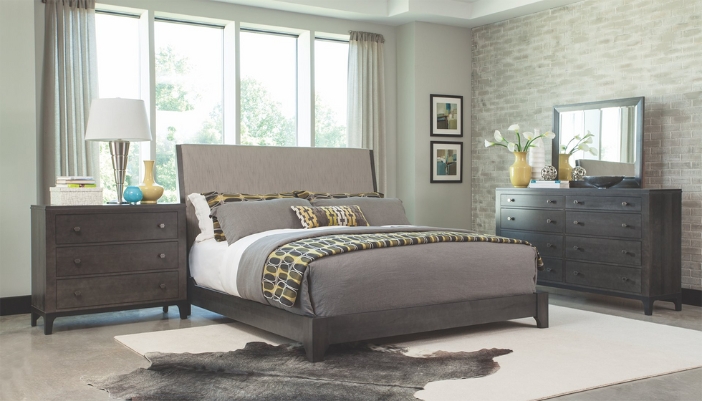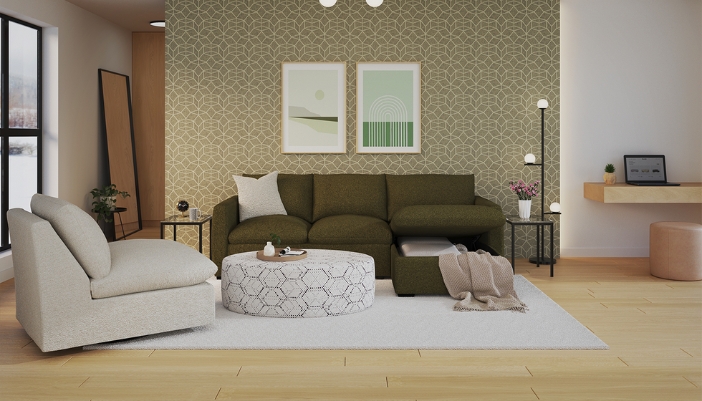
Creating a beautifully arranged room isn't about having the most expensive furniture – it's about understanding the fundamental principles that Canadian interior designers use to transform any space.
Whether you're working with a compact condo or a spacious family home, mastering these professional arrangement techniques will help you maximize flow, function, and visual appeal with quality Canadian pieces.
The Foundation: Understanding Traffic Flow
The most critical principle in furniture arrangement is establishing a clear traffic flow. Imagine invisible pathways through your room where people naturally walk. These pathways should be:
- Minimum 60cm wide for comfortable single-person passage, with 90cm being ideal for high-traffic areas. Avoid placing furniture directly in these natural walking paths, even if it means leaving some wall space empty.
- Create purposeful navigation by arranging furniture to guide movement through the room logically. In open-concept spaces, use furniture placement to define separate areas while maintaining flow between them.
The Anchor Principle: Start with Your Largest Piece
Professional designers always begin with the room's largest piece – typically a sofa, dining table, or bed. This "anchor piece" establishes the room's primary function and dictates the placement of everything else:
- Living Rooms: Position your sofa first, considering factors like natural light, television viewing angles, and conversation facilitation. Avoid pushing all furniture against walls; floating furniture pieces can create more intimate and functional arrangements.
- Dining Rooms: Centre your dining table in the space when possible, ensuring chairs can be pulled out comfortably without blocking pathways or bumping into other furniture.
- Bedrooms: Place the bed as the focal point, typically centred on the longest wall, with adequate space on both sides for movement and nightstands.
The “Triangle Technique” for Living Spaces
Create visual balance and encourage conversation by arranging seating in triangular formations. This doesn't mean perfect geometric triangles – rather, position three key seating pieces (sofa, two chairs, or sectional with accent chair) to form a triangle shape.
This arrangement ensures everyone can see each other comfortably and creates natural conversation zones. The triangle technique works whether you're using a single large sectional or combining multiple pieces.

Proportion and Scale Mastery
One hallmark of professional design is furniture that feels appropriately scaled for the space. Common mistakes include:
- Furniture that's too small makes rooms feel disjointed and incomplete. In spacious rooms, don't be afraid to use substantial pieces that fill the space appropriately.
- Overcrowding with too many pieces creates visual chaos and impedes function. Sometimes less truly is more – choose fewer, quality pieces over numerous smaller items.
- Ignoring the ceiling height when selecting furniture. Rooms with high ceilings can accommodate taller pieces like armoires or tall bookcases that would overwhelm standard-height spaces.
The Magic of Angles
While it might seem natural to line everything up parallel to walls, introducing angles creates visual interest and can improve function:
- Angle accent chairs slightly toward the main seating area to encourage conversation and create a more dynamic arrangement.
- Position occasional tables at slight angles rather than perfectly parallel to nearby furniture – this creates a more relaxed, lived-in feeling.
- Use diagonal placement in large rooms to make better use of space and create more intimate groupings within the larger area.
Balancing Function with Beauty
Professional arrangements never sacrifice function for appearance. Each piece should serve a purpose while contributing to the room's overall aesthetic:
- Ensure adequate task lighting by positioning table lamps and floor lamps where they'll be used for reading or conversation.
- Create convenient surfaces near seating for beverages, books, and personal items. Every seat should have access to a side table or surface within arm's reach.
- Plan for real-life activities by leaving space for everyday functions like opening drawers, pulling out desk chairs, or accessing storage.
Common Arrangement Mistakes to Avoid
Learning from common errors helps you achieve professional-looking results:
- Pushing all furniture against the walls creates a bowling alley effect and wastes the room's centre. Pull pieces into the space to create intimate groupings.
- Ignoring the room's natural focal point, such as a fireplace, a large window, or an architectural feature. Work with these elements rather than competing against them.
- Forgetting about scale relationships between pieces. Mix different sizes thoughtfully – combine large and small elements rather than using all similarly-sized furniture.
- Blocking natural light with poorly positioned furniture. Arrange pieces to maximize daylight while maintaining function.
Room-Specific Tips
- Living Rooms: Create multiple conversation areas in large spaces by using area rugs to define separate zones. Ensure the main seating arrangement focuses on both the television and a secondary focal point like a fireplace.
- Dining Rooms: Allow 60cm of space behind chairs when pushed in, and ensure the chandelier or pendant light is centred over the table, not the room.
- Bedrooms: Position the bed so you can see the doorway from it (for psychological comfort) while ensuring both sides are accessible for two-person occupancy.

Bringing it All Together with Smitty’s
Professional furniture arrangement is about creating spaces that work beautifully for your specific lifestyle. While these fundamental principles provide an excellent foundation, sometimes the best results come from expert guidance tailored to your unique space and needs.
At Smitty's Furniture, our certified design consultants use these same professional principles to help Ontario families create flawlessly arranged homes. Whether you need a complimentary in-store consultation to discuss your space challenges or prefer a comprehensive in-home design service, our team can help you achieve that perfect balance of beauty and function.
Visit any of our showroom locations to experience professionally arranged room displays and see how quality Canadian furniture works in thoughtfully planned spaces. Our design consultants can help you visualize how these arrangement principles will work in your specific home, taking the guesswork out of creating your ideal living environment.